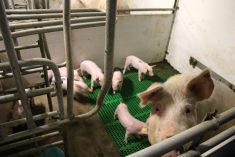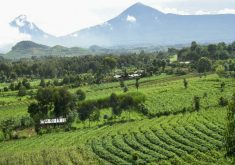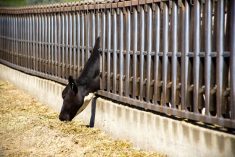If you’ve ever had a trampoline in your backyard, you may have seen the unreasonably tall grass growing under it. This is because many crops, including these grasses, actually grow better when protected from the sun, to an extent.
Researchers in the field of solar photovoltaic technology—a fancy way of saying ‘how to use solar cells to convert sunlight directly into electricity’—have been shading large crop lands with solar panels on purpose.
The practice of growing crops in the protective shadow of solar panels is called agrivoltaic farming, and it is happening in Canada. Such farming can help meet Canada’s food and energy needs and reduce its fossil fuel reliance and greenhouse gas emissions in the future.
Read Also

100TH ANNIVERSARY: Where does ‘co-op’ fit in the Manitoba Co-operator after a century of farm reporting?
The Manitoba Co-operator is no longer owned by a co-operative, as it was at the start of its run, but Manitoba’s farm paper still reflects the spirit of co-operation that built this province
Our recently published paper found that Canada has an enormous agrivoltaic potential, as it is a global agricultural powerhouse. Many crops grown here, including corn, lettuce, potatoes, tomatoes, wheat and pasture grass, have already been proven to increase with agrivoltaics.
Studies from all over the world have shown crop yields increase when the crops are partially shaded with solar panels. These yield increases are possible because of the microclimate created underneath the panels that conserves water and protects plants from excess sun, wind, hail and soil erosion.
As the costs of solar energy plummet, nations are installing agrivoltaic systems and offsetting the burning of fossil fuels by profitably producing more renewable energy. In Europe, solar panels are put over different types of crops, including fruit trees. In China, agrivoltaics are used to reverse desertification.
Surveys of the rural U.S., from Michigan to Texas, show 81.8 per cent of respondents would be more likely to support solar development in their community if it integrated farming. Rural residents generally like the idea of maintaining agricultural jobs, increased revenue from the sale of energy and the fact that it could provide a continued source of income. They believe it can act as a buffer against inflation and bad growing seasons.
In Canada, agrivoltaics has primarily been applied to conventional solar farms and used by sheep operations. While farmers get paid to cut the grass on solar farms, the sheep use the grass and pastures under the solar panels for shade and grazing. Sheep-based agrivoltaics is found throughout Canada.
The life-cycle analysis of agrivoltaics, which assesses its impact from its conception to use, found that these solar-covered farms emit 69.3 per cent less greenhouse gas and demand 82.9 per cent less fossil energy compared to when the farm and solar energy production are kept separate.
This is great, but to remain competitive with other major agriculture producers, Canada needs to start large-scale agriculture in the shadow of solar panels. This will enable the production of numerous crops that have been known to increase yield when covered.
This would include vegetables like broccoli, celery, peppers, lettuce, spinach and tomatoes as well as field crops like potatoes, corn and wheat.
Seriously embracing agrivoltaics in Canada would drop fossil fuel use. Less than one per cent of Canadian land would be sufficient to support over 25 per cent of the country’s electrical energy needs using this system. This, in turn, can help the nation honour its commitment to reducing greenhouse gas emissions by increasing the non-emitting share of electricity generation to 90 per cent by 2030.
The potential of agrivoltaic-based solar energy production in Canada far outstrips current electric demand. This solar energy can be used to electrify and decarbonize transportation and heating, expand economic opportunities by powering the burgeoning computing sector—any extra agrivoltaic electricity could be used to power computing facilities and cryptocurrency miners at profit—and export green electricity to the U.S. to help eliminate their dependence on fossil fuels as well.
Despite the numerous benefits of agrivoltaic farming, there are barriers to its distribution in Canada. There are well-intentioned regulations that hold these farms back.
In Ontario, for example, you cannot install solar in the Greenbelt because of the law to protect farms. Similar issues arise in Alberta on Crown land.
In the old days, that made sense. We did not want to repeat the U.S. fiasco of raising food prices in exchange for energy crops. Now we know that with agrivoltaics, we can get more food while using solar technology to make electricity.
The other main issue holding agrivoltaics back is capital costs. Agrivoltaics has a much higher capital cost per acre than farmers are accustomed to. Even though it is profitable, it is difficult for farmers to implement large agrivoltaic systems on their own.
This means we need new methods of financing, new partnerships and new business models to help Canada take advantage of the strategic benefits of agrivoltaics for our farmers and the country.
– This article first appeared in The Conversation, by Reuters.















